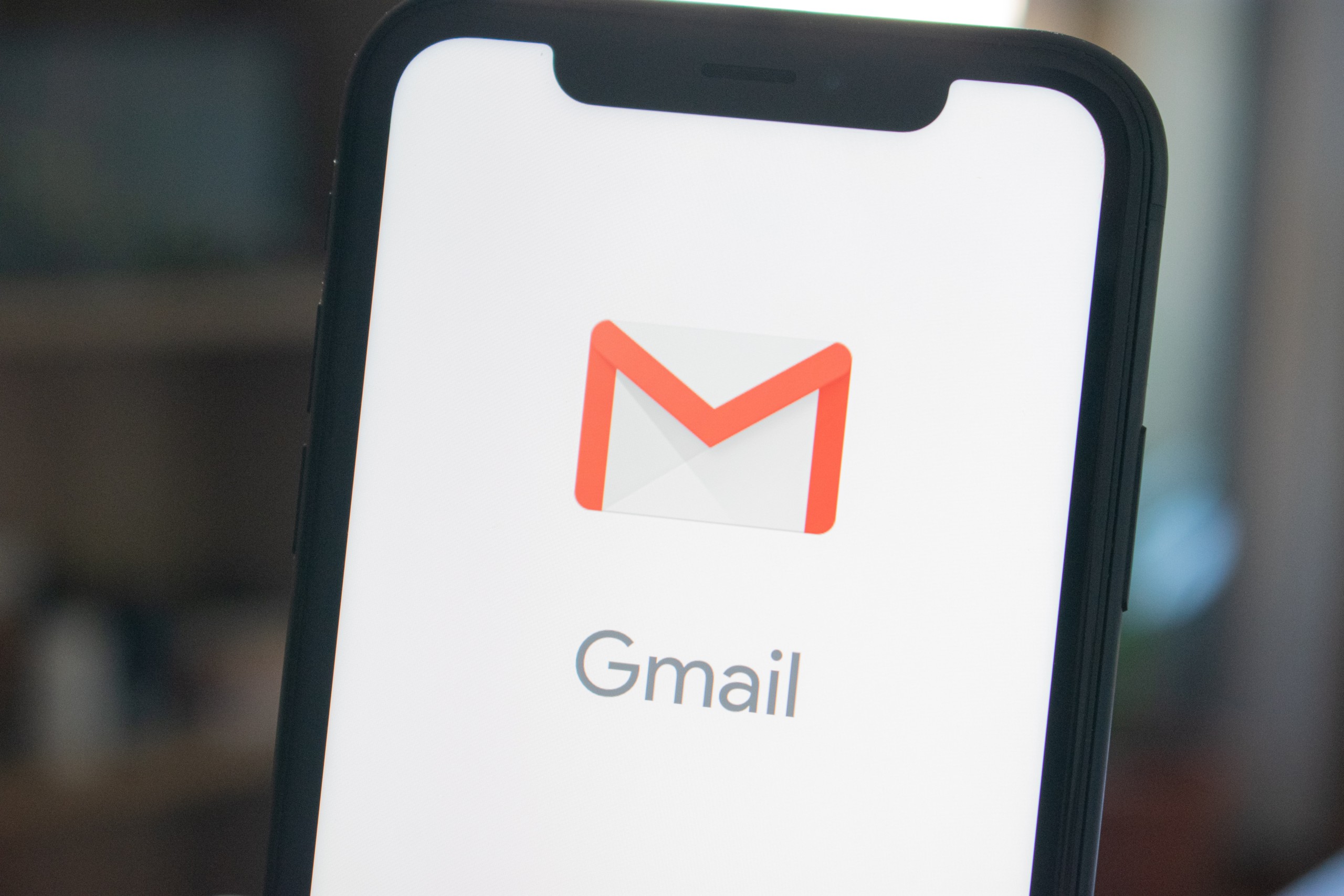We all know email marketing is valuable.
In fact, according to this article from Oberlo, for every $1 you spend on email marketing, you can expect an average return of $42 (original reference: The Data & Marketing Association)
Now, that sounds good, but if you’re one of the many businesses that sends emails, you know that getting that $42 return is not easy, especially when you’re struggling with…
✕ Low CTR
✕ Low open rates
✕ High unsubscribe rates
✕ Getting marked as SPAM
If this sounds familiar, it may be time to reevaluate your email marketing strategy and getting a better understanding of why your emails may be getting deleted, marketed as SPAM, or left unread by your subscribers.
Below, I cover the 3 most common reasons this may be happening to you and your business; let’s dive in!
#1: The content is irrelevant for the user
I don’t know about you, but I constantly get emails that are not right for me.
For example, I get SPAM emails from businesses that clearly know nothing about me and found me through some kind of email scraping tool…
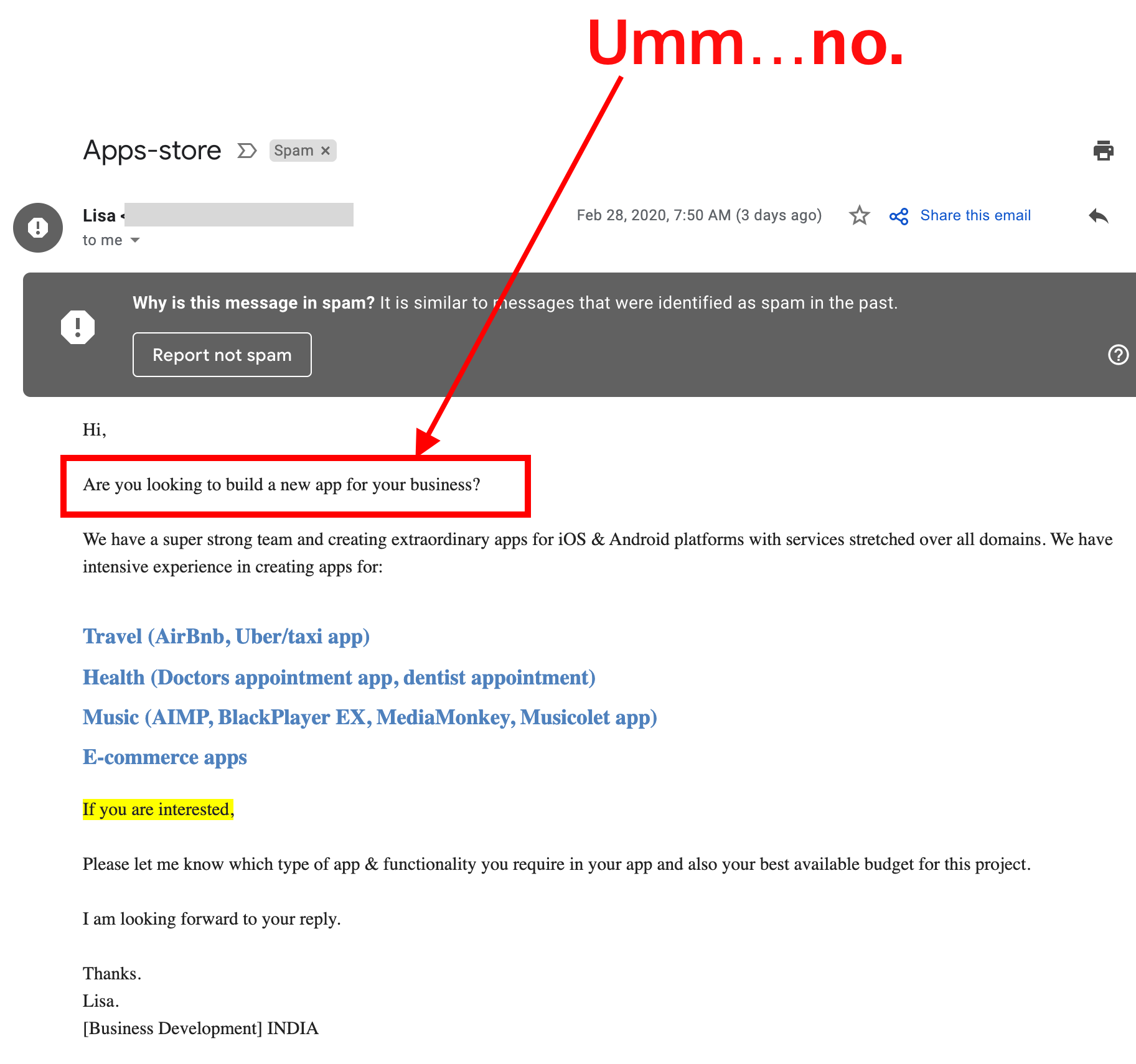
I get emails for products that are completely irrelevant for my age group, like menopause products even though I’m nowhere near that stage of my life…????
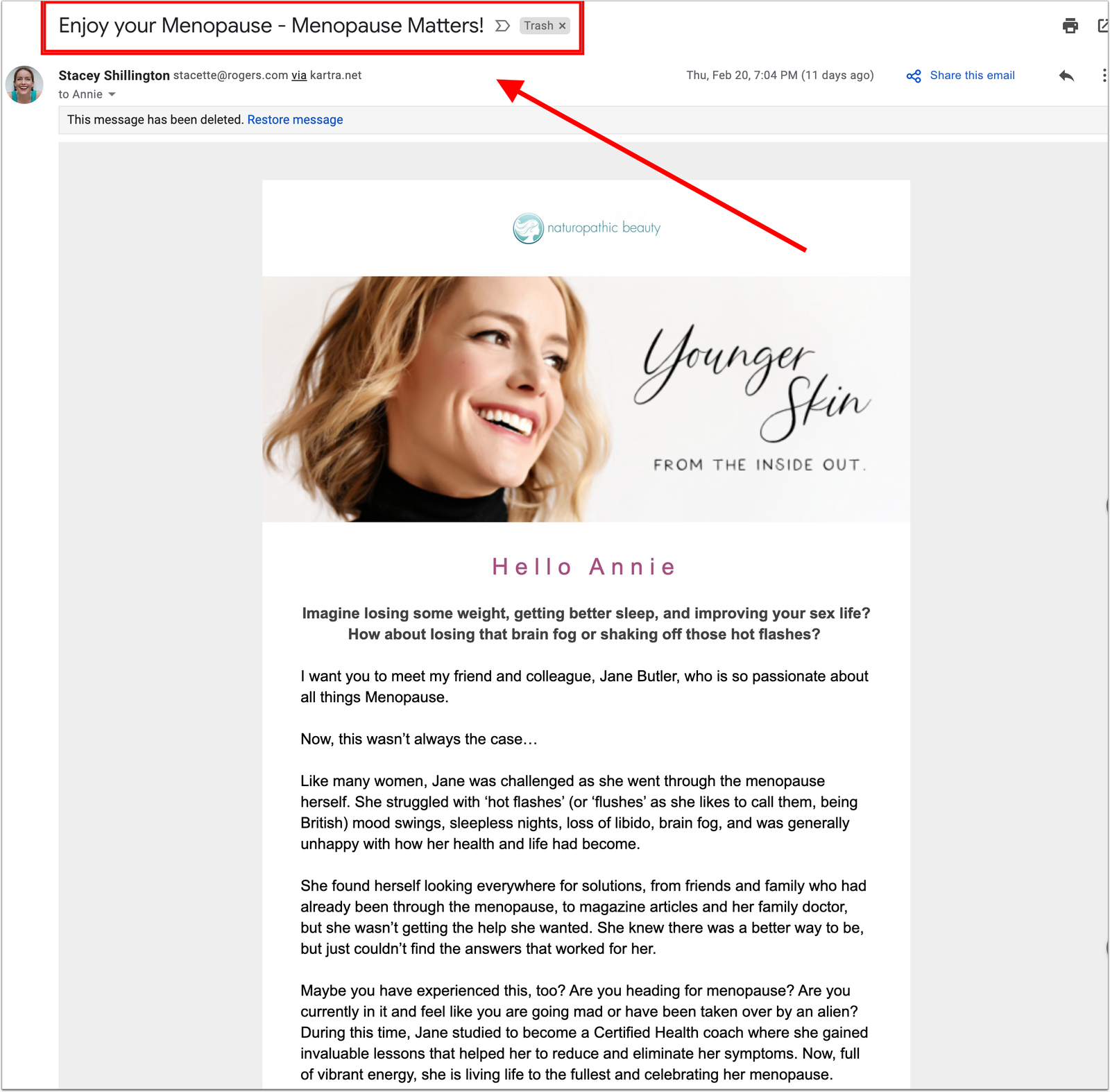
I get emails for products I have NEVER purchased and would never be interested in, like this one from Laura Mercier…

And I get emails from apps I haven’t used in YEARS trying to get me to come back with some stupid message like the one from Twitter…
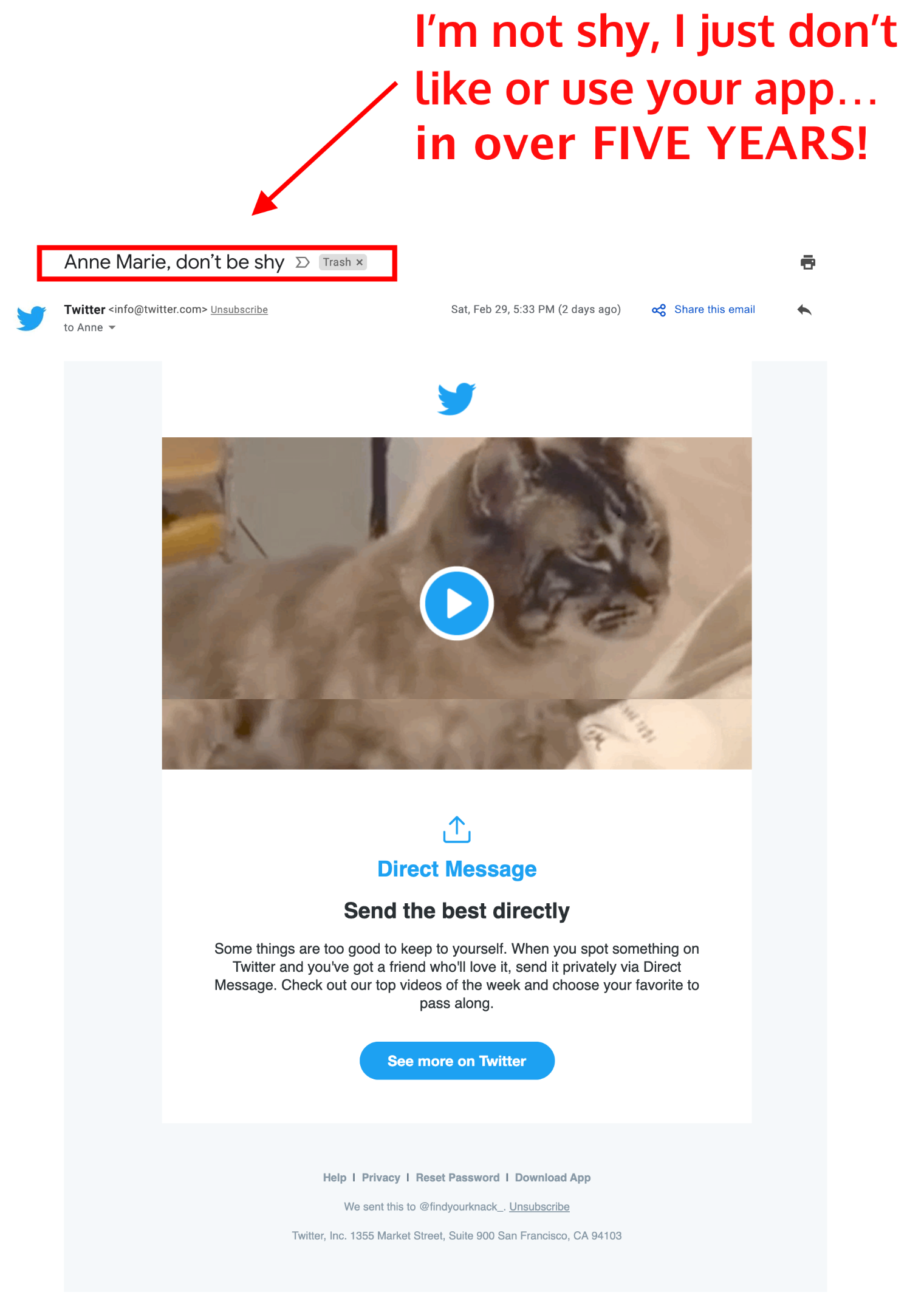
Now, you may be thinking: “you’re always going to have someone who doesn’t like your emails,” and that is true.
But it’s less likely to happen if you SEGMENT YOUR LIST!
If you’re unfamiliar, segmentation is basically taking your email list and grouping your subscribers (or customers) into groups based on a set of criteria or similarities.
For example, a segment could be a group of your customers who have all purchased a particular product. It could be a group of your subscribers who all showed interest in a particular topic. Or it could be users who signed up for a free trial through a specific landing page, but never converted to paid (as you can see, the possibilities are limitless).
Regardless of how you segment, the theory is this: by sending highly relevant emails to people who are actually interested in that topic, product, service, etc you’ll get more opens/clicks and fewer deletes/unsubscribes.
Let’s go back to the Laura Mercier example above to demonstrate.
I purchase the same product, a translucent powder, from Laura Mercier every few months. I do not purchase any other products because I don’t really wear much makeup.
Instead of blasting me with every product they sell, why not send me and email with a product that complements the one I already buy? Why not send me a link to the travel-sized translucent powder? Or tips related to coverage or foundation (aka the thing I am clearly interested in)?
The point is, if someone is on your email list, don’t waste their time with stuff that doesn’t matter to them — it’s up to you to study their behaviors (i.e. – purchasing a certain product, clicking on a certain link, opening one type of email over another, etc) and adjusting your approach accordingly.
#2: Your subject lines are delete-worthy
According to Harvest Business Review, “on average, professionals have more than 200 emails in their inbox and receive 120 new ones each day, but respond to only 25% of them.”
This means if your subject line doesn’t immediately grab attention, there’s a 75% chance it’s going to be deleted as quickly as it arrived.
To illustrate, here are some emails I found in my “Trash” folder and why they ended up there…
Trying to be too clever — What does this even mean?

Too general / vague — Why should I care?

Irrelevant — I live right down the block from this store

Who? — I don’t know “Lycette” and I don’t care about her obsession

Right off the bat, I’m noticing a lot of “lack of clarity” which is something you can easily resolve.
Here’s how I would rewrite these subject lines so they would be be more relevant to readers and less likely to get deleted:
Note: While you could argue that the “Meg Shops” email (3rd example above) shouldn’t even go out to people who live in the neighborhood, for the sake of this example, I will show you how you could reposition the information so it becomes more relevant to a local customer.
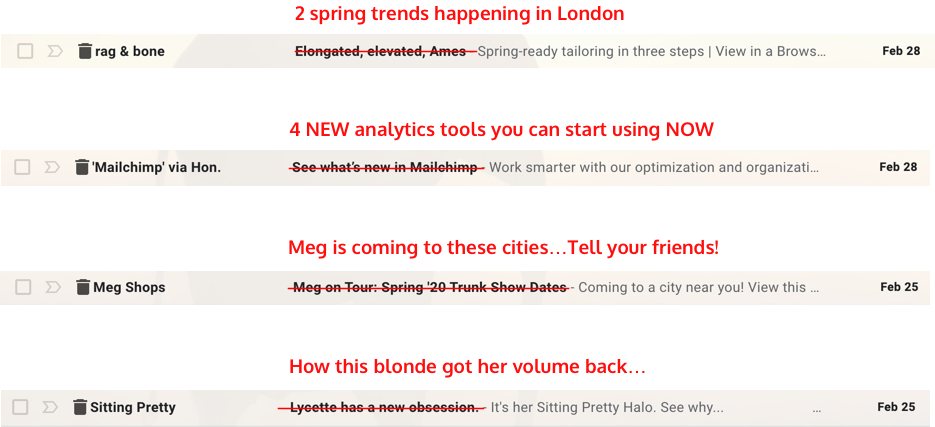
While each of these updated subject lines are very different, they have two things in common: they are all clear and specific. There is no guessing about what is in the email or whether or not you will be interested in it.
You’ll also notice that there is more of a “newsworthy” aspect built in — like there’s some kind of valuable information inside that you’ve just gotta find out.
Long story short?
Unless you’re Reformation (or it’s somehow part of your brand), keep the vague, cryptic subject lines out of your customer’s inboxes and opt for clear, specific, and value-driven copy that will entice people to open.
#3: Your emails are unfocused
How many times per day do you get long, unfocused emails like the one below?

Sorry, West Elm, but this ^ isn’t an email. It’s a freakin’ novel. It’s a never-ending landing page. It’s a quest I don’t want to tackle when I’m quickly checking my emails during my mid-day bathroom break.
To get better results (and fewer deletes), simplify your emails by structuring each one around 1 goal, 1 theme, and ONE — not TEN — ONE call-to-action.
✓ 1 goal
✓ 1 theme (idea, concept, whatever you want to call it)
✓ 1 CTA
That doesn’t mean you can’t have more than one button or link, it just means all of those CTAs should be driving toward one common goal (i.e. – shop this look, buy this thing, use this discount code, etc).
It also doesn’t mean you can’t have a long, content-heavy email; just keep it focused on one concept, one theme, one blog post, one sale, one product (or a unified collection of products)… you get the idea.
Ready to send more effective emails?
As you can see, making these small adjustments can add up to big results, so before you send your next email, make sure it checks all of the boxes below:
✓ Did I segment?
✓ Is the subject line clear & specific?
✓ Is the email focused around one goal / theme / CTA?
If you can answer “YES!” to all of the above, congratulations — you’re one step closer to earning that $42 back for every $1 you spend on email marketing.
Need help writing more effective emails? Feel free to reach out: annie1maguire@gmail.com.
